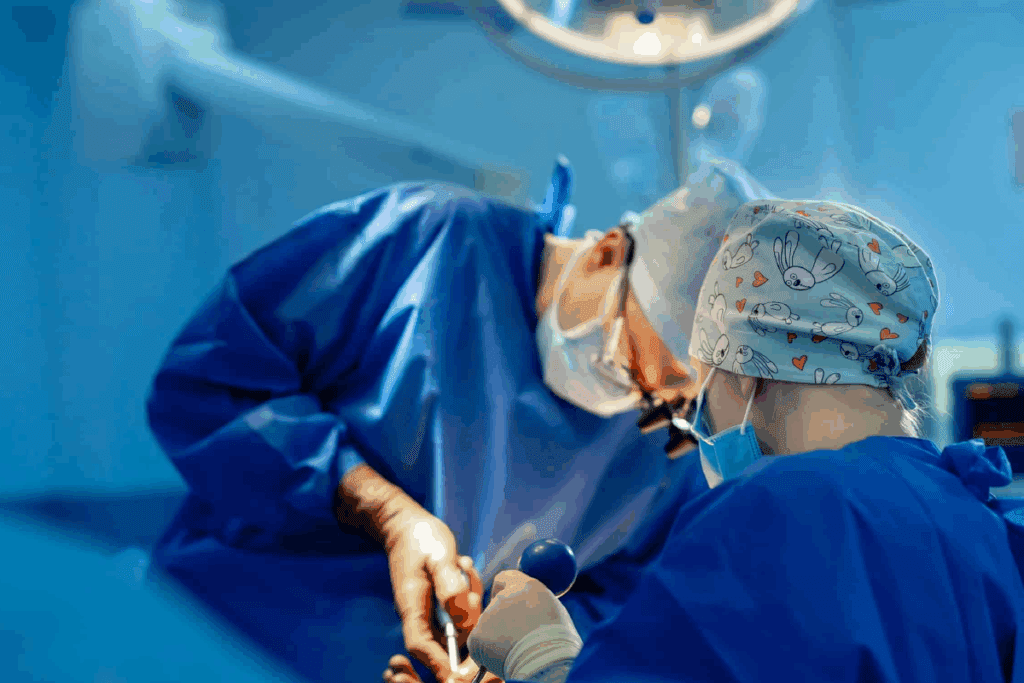Last Updated on November 26, 2025 by Bilal Hasdemir

Get 7 bad facts about biliary stones after cholecystectomy. Learn the risks, causes, and timing of post-surgery stone formation.
It’s important to know why these retained stones happen. This is true, mainly for those who have had gallstones before or have complex biliary anatomy.
At Liv Hospital, we focus on top-notch care and patient-centered innovation. We make sure patients get the latest treatments.

Removing the gallbladder changes the biliary system a lot. After surgery, the body gets used to not having this organ. But, some people might face problems with their digestive system and other issues.
The gallbladder removal changes the biliary system a lot. The bile duct takes over some jobs, but it’s not the same. This can cause problems with bile flow and concentration.
After cholecystectomy, bile goes straight from the liver to the bile duct and then to the intestine. This new way can affect digestion and might cause problems like biliary stones.
How well the body adapts to these changes varies. It’s important to understand these changes to manage risks.

Biliary stones can form in some patients after their gallbladder is removed. This happens because the biliary system changes after surgery.
These stones usually appear in the common bile duct (CBD). They can lead to serious problems like blockages, pain, and infections. It’s key to know about these stones to take good care of patients.
Research shows that about 10% of patients get symptomatic CBD stones after gallbladder surgery. This shows why it’s important to watch patients closely after surgery. Knowing about these risks helps doctors and patients stay alert.
Also, about 10% of people with gallstones will show symptoms within 5 years. The same risk is true for those who had their gallbladder removed. Spotting this risk early can help prevent more problems.
Understanding the risks and how common these stones are helps doctors take better care of patients. This can lead to better results for those who have their gallbladder removed.
It’s important to know the difference between retained and recurrent biliary stones for good care after surgery. After a cholecystectomy, patients might get biliary stones. These can be two types, based on when and how they form.
Retained stones are those left in the bile ducts during surgery. They were there before but not taken out. These stones can cause problems like blockages and infections.
Recurrent stones form in the bile ducts after surgery. They come from changes in bile and flow. These stones can cause the same symptoms as before the surgery.
Retained and recurrent stones are different in what they’re made of. Retained stones are like the original gallstones. Recurrent stones might be different because of changes in the bile after surgery. Knowing this helps doctors plan the right treatment.
The main differences between retained and recurrent stones are:
Understanding these differences is key to managing biliary stones well after cholecystectomy. It helps reduce the risk of complications.
It’s important to know when biliary stones can form after a cholecystectomy. This knowledge helps doctors plan better care for their patients. Stones can appear at different times after surgery, which affects how they are managed.
Research shows that most people get biliary stones again about 26 months after surgery. This fact stresses the need for constant watchfulness in patients who have had their gallbladder removed. Regular check-ups are key to catching problems early.
Many stones that stay behind after surgery are found within three years. This time frame is important for keeping an eye on and handling any problems. Stones can cause abdominal pain and jaundice.
The risk of getting biliary stones is higher in the first few years after surgery. But, the risk doesn’t go away. Things like bile stasis and changes in bile can keep the risk alive. A thorough long-term risk assessment helps find who needs extra care.
Here are the main points about when biliary stones can develop:
Knowing these timelines helps doctors plan better care for their patients.
Several key factors can increase the likelihood of developing biliary stones after gallbladder removal. It’s important to know these risk factors. This helps identify patients who need closer monitoring or preventive measures.
Patients with multiple gallstones at first are at higher risk. This suggests a more complex biliary issue. It may lead to a higher chance of stone formation in the bile ducts.
A periampullary diverticulum, Types 1 and 2, is a big risk factor. It can cause bile stasis and stone formation. The diverticulum can make bile flow harder, leading to stone development.
A dilated common bile duct also raises the risk of biliary stones. Dilation can be due to obstruction or other factors. It creates a perfect environment for stones to form.
Bile stasis is key in biliary stone formation. Impaired bile flow concentrates bile components. This increases the risk of stone formation. Knowing how bile stasis works is vital for preventing stones.
In conclusion, knowing these risk factors helps manage patients at higher risk of biliary stones after gallbladder removal. Healthcare providers can then take the right steps to monitor and prevent stones.
It’s important to know the signs of biliary stones after gallbladder surgery. These symptoms can happen if stones form in the bile ducts. Knowing them helps in getting the right treatment.
The symptoms of post-cholecystectomy biliary stones are similar to those of primary gallstone disease. They include pain, discomfort, nausea, vomiting, and fever. These happen because the stones block the bile ducts.
It’s key to tell the symptoms of biliary stones from other surgery problems. This makes sure patients get the right treatment on time.
If you have severe pain, jaundice, fever, or keep vomiting, see a doctor. Quick medical check-up is needed to handle any serious issues.
| Symptom | Description | Action Required |
| Severe Abdominal Pain | Pain that is intense and unrelenting | Seek immediate medical attention |
| Jaundice | Yellowing of the skin and eyes | Consult a doctor promptly |
| Fever and Vomiting | Presence of fever with persistent vomiting | Seek medical help urgently |
It’s key to accurately diagnose biliary stones after surgery. This is because different methods are used to find these stones. Finding them right is important to avoid problems and treat them properly.
Advanced imaging is a big help in finding biliary stones after surgery. Tools like ultrasound, CT scans, and MRI are used to see inside the biliary system. Ultrasound is often the first choice because it’s easy and works well for spotting stones and blockages.
CT scans give detailed pictures of the body’s cross-sections. They help find stones and check for any extra problems. MRI, or MRCP, shows the biliary tree clearly without needing contrast. This makes it great for spotting stones.
Laboratory tests are also key in finding biliary blockages caused by stones. High levels of liver enzymes like alkaline phosphatase and gamma-glutamyl transferase can mean there’s a blockage. Watching bilirubin levels, both direct and indirect, is also important. A rise in direct bilirubin points to a blockage.
These lab results, along with what imaging shows, help doctors figure out if there are stones and how bad the blockage is.
Finding biliary stones in people who’ve had their gallbladder removed can be tough. This is because their body’s layout has changed and symptoms can be vague. Doctors need to be careful and use a mix of history, lab tests, and imaging to find stones accurately.
The hard part of diagnosing shows why a detailed approach is needed. It’s all about matching the right tests to the person’s post-surgery body and symptoms.
Managing biliary stones after gallbladder removal is key. It involves a mix of treatments. This approach helps tackle the problem from different angles.
ERCP is a top choice for treating biliary stones after gallbladder removal. It uses an endoscope to reach the stones through the mouth and small intestine.
The ERCP method is less invasive. It lets doctors see and clear the bile ducts directly.
Sometimes, surgical intervention is needed for biliary stones. This can include more detailed procedures to clear the bile ducts or fix underlying issues.
Medical management is vital for treating biliary stones. It helps prevent them from coming back. This includes using medicines to dissolve or prevent stones.
Ursodeoxycholic acid (UDCA) is often used to dissolve cholesterol stones.
Recovery times vary based on the treatment. ERCP, being less invasive, usually means a faster recovery. This is compared to more complex surgeries.
To lower the chance of getting biliary stones again, try dietary modifications, medication options, and lifestyle choices.
Eating less fat and more fiber can cut down on biliary stone risk. Foods like salmon, rich in omega-3s, and berries, full of antioxidants, are good choices.
| Dietary Component | Recommended Foods |
| Low Fat | Lean proteins, vegetables |
| High Fiber | Fruits, whole grains |
| Omega-3 Rich | Salmon, walnuts |
Medicines like ursodeoxycholic acid (UDCA) can stop biliary stones from forming. They help bile flow better.
Staying active and keeping a healthy weight is key for biliary health. Avoiding rapid weight loss is also important to prevent stone formation.
By using these strategies, patients can greatly lower their risk of getting biliary stones again.
If left untreated, biliary stones can lead to serious problems. These issues can greatly affect a person’s quality of life and health.
Untreated biliary stones can cause acute cholangitis, a serious infection of the bile duct. Symptoms include fever, jaundice, and abdominal pain. If not treated, it can turn into sepsis, a deadly condition.
Biliary stones can also cause pancreatitis, an inflammation of the pancreas. This condition is very painful and can be dangerous. The risk of pancreatitis is higher if the stones move into the pancreatic duct.
Untreated biliary stones can block the bile duct for a long time. This can damage the liver. It can lead to cirrhosis, a condition where the liver scars, and even liver failure if not treated.
| Complication | Description | Potential Consequences |
| Acute Cholangitis | Bacterial infection of the bile duct | Sepsis, organ failure |
| Pancreatitis | Inflammation of the pancreas | Severe pain, organ failure |
| Liver Damage | Prolonged bile duct obstruction | Cirrhosis, liver failure |
Prompt medical attention is key for those with biliary stones. It helps prevent complications and ensures timely treatment.
Dealing with biliary stones in high-risk patients is complex. These patients often have many health issues. This makes diagnosing and treating them harder.
Elderly patients with biliary stones can be tricky to diagnose. Their symptoms might not be typical. Doctors need to look at their overall health and the risks of surgery.
Patients with many health problems need a special plan. This plan must weigh the benefits and risks of treatment. It’s important to think about how treatments might affect their other conditions.
Pregnant women with biliary stones are a special case. Doctors must protect both the mother and the baby. Often, treatments are delayed until after the baby is born, unless it’s an emergency.
| Patient Group | Key Considerations | Management Strategies |
| Elderly Patients | Atypical symptoms, comorbidities | Comprehensive geriatric assessment, minimally invasive procedures |
| Patients with Multiple Comorbidities | Complex medical history, possible drug interactions | Multidisciplinary care team, careful medication management |
| Pregnant Women | Fetal safety, delayed treatment | Monitoring, ERCP when necessary, postpone surgery until postpartum |
After a cholecystectomy, keeping your biliary health in check is key. This helps avoid future problems. It’s important to know the risks of getting biliary stones.
Knowing the risks and taking steps to prevent them can help. Changing your diet, lifestyle, and using certain medications can help keep your biliary system healthy.
Seeing your healthcare provider regularly is also vital. They can check on your biliary health and fix any issues quickly. Taking care of your biliary health can help you stay well after your surgery.
Subscribe to our e-newsletter to stay informed about the latest innovations in the world of health and exclusive offers!